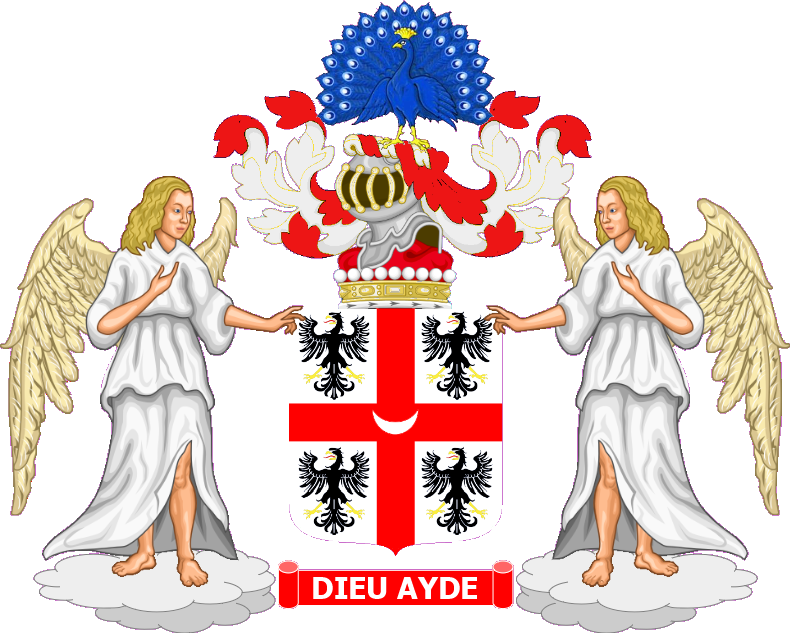|
Montague Browne
The Hon Montague Browne (Henry Montague Browne; 3 October 1799–24 November 1884) was Dean of Lismore from 1850 until 1884. He was the second son of James Browne, 2nd Baron Kilmaine. He began his ecclesiastical career with a curacy at Christ Church Cathedral, Waterford. After that he was Rector of Shanrahan then Clonmel.'' Crockford's Clerical Directory 1929-30'' London: Oxford University Press, 1929 p 763 He married Catherine Penelope de Montmorency, daughter of Lodge Evans de Montmorency, 1st Viscount Frankfort de Montmorency. Their fourth child and second daughter, Augusta, married Lieutenant-General Arthur Cavendish-Bentinck and was the first Baroness Bolsover Baron Bolsover, of Bolsover Castle in the County of Derby, was a title in the Peerage of the United Kingdom. It was created on 23 April 1880 (as Baroness Bolsover) for Augusta Cavendish-Bentinck, with remainder to the heirs male of the body of .... References {{DEFAULTSORT:Browne, Montague Alumn ... [...More Info...] [...Related Items...] OR: [Wikipedia] [Google] [Baidu] |
The Very Reverend
The Very Reverend is a Style (manner of address), style given to members of the clergy. The definite article "The" should always precede "Reverend" as "Reverend" is a style or fashion and not a title. Catholic In the Catholic Church, the style is given, by custom, to priests who hold positions of particular note: e.g. vicars general, episcopal vicars, judicial vicars, ecclesiastical judges, vicars forane (deans or archpriests), provincials of religious orders, rectors or presidents of cathedrals, seminaries or colleges/universities, priors of monasteries, Canon (priest), canons, for instance. (The style is ignored if the holder is a monsignor or a bishop; otherwise, a priest who is "Very Reverend" continues to be addressed as Father.) Monsignors of the grade of Chaplain of His Holiness were formerly styled as ''The Very Reverend Monsignor'', while honorary prelates and protonotary apostolics were styled ''The Right Reverend Monsignor''. Now, apart from legitimate custom or acquire ... [...More Info...] [...Related Items...] OR: [Wikipedia] [Google] [Baidu] |
Christ Church Cathedral, Waterford
Christ Church Cathedral, Waterford, or more formally, the Cathedral of The Holy Trinity, Christ Church, is a cathedral of the Church of Ireland in Waterford City, Ireland. It is in the ecclesiastical province of Dublin. Previously the cathedral of the Diocese of Waterford, it is now one of six cathedrals in the United Dioceses of Cashel and Ossory. Ecclesiastical history The first church on the site was built in the 11th century. In 1170 it was the venue for the marriage of Richard de Clare, 2nd Earl of Pembroke ("Strongbow"), and Aoife Ní Diarmait. This was replaced in 1210 by a Gothic Cathedral. Since Christ Church Cathedral was subject to the Protestant Reformation, Roman Catholic adherents were consequently obliged to worship elsewhere. In the 18th century, the city corporation recommended that the bishop erect a new building. The architect was John Roberts, who was responsible also for the Catholic cathedral and for much of Georgian Waterford. During the demolition of ... [...More Info...] [...Related Items...] OR: [Wikipedia] [Google] [Baidu] |
Deans Of Lismore
Deans may refer to: People * Austen Deans (1915–2011), New Zealand painter and war artist * Colin Deans (born 1955), Scottish rugby union player * Craig Deans (born 1974), Australian football (soccer) player * Diane Deans (born 1958), Canadian politician * Dixie Deans (born 1946), Scottish football player (Celtic) * Ian Deans (1937–2016), Canadian politician * Kathryn Deans, Australian author * Mickey Deans (1934–2003), fifth and last husband of Judy Garland * Ray Deans (born 1966), Scottish football player * Robbie Deans (born 1959), New Zealand rugby coach and former player * Steven Deans (born 1982), ice hockey player * Tommy Deans (1922–2000), Scottish football (soccer) player * More than one Dean Places * Deans, New Jersey * Deans, West Lothian Deans is a small community within the town of Livingston, West Lothian, Livingston in West Lothian, Scotland. Deans is situated in the northern part of Livingston, The western area of Deans was formerly known as Livingston Stat ... [...More Info...] [...Related Items...] OR: [Wikipedia] [Google] [Baidu] |
Alumni Of Trinity College Dublin
Alumni (singular: alumnus (masculine) or alumna (feminine)) are former students of a school, college, or university who have either attended or graduated in some fashion from the institution. The feminine plural alumnae is sometimes used for groups of women. The word is Latin and means "one who is being (or has been) nourished". The term is not synonymous with "graduate"; one can be an alumnus without graduating ( Burt Reynolds, alumnus but not graduate of Florida State, is an example). The term is sometimes used to refer to a former employee or member of an organization, contributor, or inmate. Etymology The Latin noun ''alumnus'' means "foster son" or "pupil". It is derived from PIE ''*h₂el-'' (grow, nourish), and it is a variant of the Latin verb ''alere'' "to nourish".Merriam-Webster: alumnus .. Separate, but from the ... [...More Info...] [...Related Items...] OR: [Wikipedia] [Google] [Baidu] |
Thomas Stewart Townsend
Thomas Stewart Townsend (1800–1852) was an Irish Anglican bishop in the Church of Ireland in the 19th century. He was successively Dean of Lismore and Dean of Waterford to 1850. He became Bishop of Meath in 1850 and died in post in Málaga on 16 September 1852. His Times obituary noted that "by his death the system of national education has lost an earnest advocate".The Times ''The Times'' is a British daily national newspaper based in London. It began in 1785 under the title ''The Daily Universal Register'', adopting its current name on 1 January 1788. ''The Times'' and its sister paper ''The Sunday Times'' (fou ..., Thursday, 30 September 1852; pg. 8; Issue 21234; col A Ireland. (From our own correspondent.) References 1800 births 1852 deaths Townsend family Deans of Lismore Deans of Waterford 19th-century Anglican bishops in Ireland Anglican bishops of Meath {{Ireland-Anglican-bishop-stub ... [...More Info...] [...Related Items...] OR: [Wikipedia] [Google] [Baidu] |
Baron Bolsover
Baron Bolsover, of Bolsover Castle in the County of Derby, was a title in the Peerage of the United Kingdom. It was created on 23 April 1880 (as Baroness Bolsover) for Augusta Cavendish-Bentinck, with remainder to the heirs male of the body of her late husband Lieutenant-General Arthur Cavendish-Bentinck (1819–1877), younger son of Lord Charles Bentinck, third son of William Cavendish-Bentinck, 3rd Duke of Portland. Lady Bolsover was the daughter of the Very Reverend Henry Montague Browne, Dean of Lismore, second son of James Caulfeild Browne, 2nd Baron Kilmaine.''DEATH OF THE BARONESS BOLSOVER'' Nottinghamshire Guardian (London, England), Saturday, August 12, 1893; pg. 5; Issue 2517 She was succeeded according to the special remainder by her stepson William Cavendish-Bentinck, 6th Duke of Portland, who became the second Baron Bolsover. He was the only child from Arthur Cavendish-Bentinck's first marriage, to Elizabeth Sophia Hawkins-Whitshed. The barony remained united with ... [...More Info...] [...Related Items...] OR: [Wikipedia] [Google] [Baidu] |
Lodge De Montmorency, 1st Viscount Frankfort De Montmorency
Lodge Evans de Montmorency, 1st Viscount Frankfort de Montmorency PC (26 January 1747 – 21 September 1822), known as Lodge Morres until 1800 and as The Lord Frankfort between 1800 and 1816, was an Irish politician. Background Born Lodge Morres, he was the son of Redmond Morres and Elizabeth, daughter of Francis Lodge. Hervey Morres, 1st Viscount Mountmorres and Sir William Morres, 1st Baronet, were his uncles. Political career Morres was elected a member of the Irish House of Commons for Inistioge in 1768, a seat he held until 1770, and later represented Bandon Bridge between 1776 and 1796, Ennis between 1796 and 1797, and Dingle between 1798 and 1800. He was sworn of the Irish Privy Council in 1796 and served as a Lord of the Treasury between 1796 and 1806. In 1800 he was raised to the Peerage of Ireland as Baron Frankfort, of Galmoye in the County of Kilkenny. In 1815 he assumed by Royal licence the surname of de Montmorency in lieu of Morres, although the French House o ... [...More Info...] [...Related Items...] OR: [Wikipedia] [Google] [Baidu] |
Clonmel
Clonmel () is the county town and largest settlement of County Tipperary, Republic of Ireland, Ireland. The town is noted in Irish history for its resistance to the Cromwellian conquest of Ireland, Cromwellian army which sacked the towns of Drogheda and Wexford. With the exception of the townland of Suir Island, most of the borough is situated in the Civil parishes in Ireland, civil parish of "St Mary's" which is part of the ancient Barony (Ireland), barony of Iffa and Offa East. Population The 2016 Census used a new boundary created by the Central Statistics Office (Ireland), Central Statistics Office (CSO) to define the town of Clonmel and Environs resulting in a population figure of 17,140. This new boundary omitted part of the Clonmel Borough Boundary which the CSO had defined as Legal Town for the 2011 census 11.55 km/sq. All of the 2011 census CSO environs in Co Waterford have been omitted as well as parts of CSO environs of Clonmel in Co Tipperary. The CSO as part of ... [...More Info...] [...Related Items...] OR: [Wikipedia] [Google] [Baidu] |
List Of Townlands Of County Tipperary
This is a sortable table of the approximately 3,245 townlands of County Tipperary, Ireland. Retrieved: 2010-09-18. Duplicate names occur where there is more than one townland with the same name in the county. Names marked in bold typeface are towns and villages, and the word ''Town'' appears for those entries in the Acres column. Townland list References {{reflist |
Rector (ecclesiastical)
A rector is, in an ecclesiastical sense, a cleric who functions as an administrative leader in some Christian denominations. In contrast, a vicar is also a cleric but functions as an assistant and representative of an administrative leader. Ancient usage In ancient times bishops, as rulers of cities and provinces, especially in the Papal States, were called rectors, as were administrators of the patrimony of the Church (e.g. '). The Latin term ' was used by Pope Gregory I in ''Regula Pastoralis'' as equivalent to the Latin term ' (shepherd). Roman Catholic Church In the Roman Catholic Church, a rector is a person who holds the ''office'' of presiding over an ecclesiastical institution. The institution may be a particular building—such as a church (called his rectory church) or shrine—or it may be an organization, such as a parish, a mission or quasi-parish, a seminary or house of studies, a university, a hospital, or a community of clerics or religious. If a r ... [...More Info...] [...Related Items...] OR: [Wikipedia] [Google] [Baidu] |
Curate
A curate () is a person who is invested with the ''care'' or ''cure'' (''cura'') ''of souls'' of a parish. In this sense, "curate" means a parish priest; but in English-speaking countries the term ''curate'' is commonly used to describe clergy who are assistants to the parish priest. The duties or office of a curate are called a curacy. Etymology and other terms The term is derived from the Latin ''curatus'' (compare Curator). In other languages, derivations from ''curatus'' may be used differently. In French, the ''curé'' is the chief priest (assisted by a ''vicaire'') of a parish, as is the Italian ''curato'', the Spanish ''cura'', and the Filipino term ''kura paróko'' (which almost always refers to the parish priest), which is derived from Spanish. Catholic Church In the Catholic Church, the English word "curate" is used for a priest assigned to a parish in a position subordinate to that of the parish priest. The parish priest (or often, in the United States, the "pastor ... [...More Info...] [...Related Items...] OR: [Wikipedia] [Google] [Baidu] |




